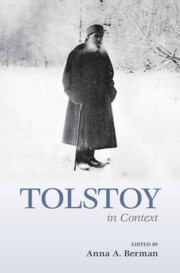Book contents
- Tolstoy in Context
- Tolstoy in Context
- Copyright page
- Contents
- Figures
- Notes on Contributors
- Preface
- Acknowledgments
- Note on Citations, Translations, and Transliterations
- Chronology
- Part I The Man
- Part II Russian Social and Political Contexts
- Part III Literature, the Arts, and Intellectual Life
- Chapter 16 Tolstoy’s Oeuvre
- Chapter 17 Peasant Schools and Education
- Chapter 18 Russian Philosophy
- Chapter 19 The Russian Literary Scene
- Chapter 20 European Literature
- Chapter 21 European Philosophy
- Chapter 22 Theater
- Chapter 23 Music
- Chapter 24 The Visual Arts
- Part IV Science and Technology
- Part V Beyond Russia
- Part VI Tolstoy’s Afterlife
- Suggested Further Reading
- Index
Chapter 21 - European Philosophy
from Part III - Literature, the Arts, and Intellectual Life
Published online by Cambridge University Press: 05 January 2023
- Tolstoy in Context
- Tolstoy in Context
- Copyright page
- Contents
- Figures
- Notes on Contributors
- Preface
- Acknowledgments
- Note on Citations, Translations, and Transliterations
- Chronology
- Part I The Man
- Part II Russian Social and Political Contexts
- Part III Literature, the Arts, and Intellectual Life
- Chapter 16 Tolstoy’s Oeuvre
- Chapter 17 Peasant Schools and Education
- Chapter 18 Russian Philosophy
- Chapter 19 The Russian Literary Scene
- Chapter 20 European Literature
- Chapter 21 European Philosophy
- Chapter 22 Theater
- Chapter 23 Music
- Chapter 24 The Visual Arts
- Part IV Science and Technology
- Part V Beyond Russia
- Part VI Tolstoy’s Afterlife
- Suggested Further Reading
- Index
Summary
Many scholars and critics have maintained that Tolstoy, while a great writer, is a poor thinker, a mere amateur in philosophy. My chapter suggests that this venerable cliché of Tolstoy reception is untenable. The chapter has two parts. In the first, I discuss several philosophers with whose thinking Tolstoy engaged extensively and give a brief account of his relation to them. The main names here are well known: Jean-Jacques Rousseau, Arthur Schopenhauer, and Immanuel Kant. In the second part, I examine a somewhat unexpected but significant affinity Tolstoy’s fiction has with the thought of Baruch Spinoza. This affinity emerges most clearly in War and Peace. Although this section covers what is merely an affinity, it aims to show that Tolstoy’s greatest fictional work is one of the supreme artistic instantiations of an essentially Spinozist account of the world.
- Type
- Chapter
- Information
- Tolstoy in Context , pp. 171 - 177Publisher: Cambridge University PressPrint publication year: 2022

